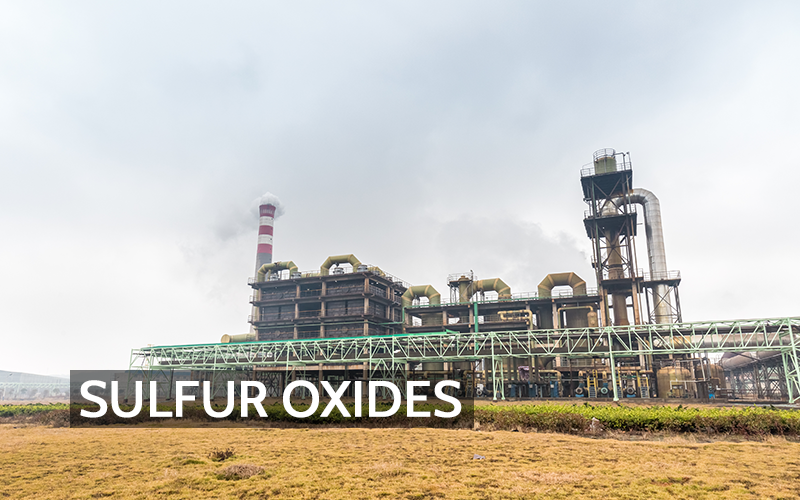Sulfur dioxide (SO₂) is a highly reactive gas known for its pungent odor and impact on air quality and public health. It belongs to the family of sulfur oxides (SOₓ), a group of pollutants regulated under the U.S. Environmental Protection Agency’s (EPA) National Ambient Air Quality Standards (NAAQS). Understanding its origins, contributors, and mitigation strategies is crucial for addressing this persistent pollutant.
What is Sulfur Dioxide?
Sulfur dioxide is a colorless gas with a sharp, irritating smell. It is produced during the combustion of fossil fuels that contain sulfur. Once released into the atmosphere, sulfur dioxide can undergo chemical reactions to form fine particulate matter (PM2.5) and acid rain, both of which have far-reaching environmental and health implications.
Exposure to sulfur dioxide, even in low concentrations, can cause respiratory problems, aggravate asthma, and lead to long-term health effects such as lung damage. Sensitive populations, including children, the elderly, and those with preexisting health conditions, are particularly vulnerable.
Sources of Sulfur Dioxide Pollution
The generation of sulfur dioxide is primarily linked to human activities, although natural sources also contribute. Below are the major contributors to SO₂ emissions:
- Power Plants: Fossil fuel-burning power plants are the largest human-made sources of sulfur dioxide. Coal and oil, which contain sulfur compounds, release SO₂ when burned for electricity generation.
- Industrial Processes: Industries such as petroleum refining, metal smelting, and chemical manufacturing emit significant quantities of sulfur dioxide during production processes.
- Transportation: Diesel engines and ships powered by heavy fuel oils contribute to localized SO₂ pollution, particularly in urban and port areas.
- Volcanic Activity: Naturally occurring sources, like volcanic eruptions, release substantial amounts of sulfur dioxide into the atmosphere, although these events are sporadic and geographically isolated.
- Residential Heating: In some regions, the use of sulfur-containing fuels for residential heating adds to the overall emissions.
Mitigation Strategies for Reducing Sulfur Dioxide Emissions
Efforts to mitigate sulfur dioxide emissions focus on technological innovation, regulatory frameworks, and changes in energy production:
- Transition to Cleaner Energy Sources: Switching from coal and oil to natural gas, renewables, and nuclear power significantly reduces sulfur dioxide emissions. For example, wind and solar energy produce zero SO₂ emissions.
- Flue Gas Desulfurization (FGD): Commonly known as “scrubbers,” FGD systems remove sulfur dioxide from exhaust gases before they are released into the atmosphere. These systems are widely deployed in power plants and industrial facilities.
- Low-Sulfur Fuels: Mandating the use of low-sulfur fuels in transportation and industry has proven effective. For instance, regulations under the International Maritime Organization (IMO) require ships to use fuels with a sulfur content of 0.5% or less, a significant reduction from the previous 3.5% limit.
- Regulatory Policies: Emission caps and trading systems incentivize industries to adopt cleaner technologies. The EPA’s Acid Rain Program, which uses a cap-and-trade approach, successfully reduced sulfur dioxide emissions from power plants by 88% between 1990 and 2020.
- Public Awareness Campaigns: Educating the public and industries about the health and environmental impacts of sulfur dioxide has led to increased compliance with regulations and voluntary adoption of emission-reducing technologies.
Global Efforts to Address Sulfur Dioxide Pollution
Sulfur dioxide reduction is a global priority, as its impacts extend beyond local or national boundaries. Acid rain, for example, can travel hundreds of miles from its source. Several international initiatives aim to tackle this issue:
- The Gothenburg Protocol: Under the United Nations Economic Commission for Europe (UNECE), this protocol establishes binding targets for sulfur dioxide and other pollutants. Participating countries have reported significant reductions in emissions since its adoption.
- International Maritime Organization (IMO) Regulations: The IMO’s 2020 sulfur cap has been a landmark policy in reducing SO₂ emissions from the shipping sector globally. Early reports suggest a marked improvement in air quality around major shipping lanes.
- Collaborative Research and Development: Partnerships among governments, research institutions, and industries focus on developing cost-effective technologies to further reduce sulfur dioxide emissions. For instance, advancements in carbon capture and storage (CCS) technologies may complement efforts to curb SO₂ emissions from industrial sources.
Challenges and Future Outlook
Despite significant progress, several challenges remain. Developing countries often struggle to implement costly emission-reduction technologies. Additionally, enforcement of international regulations can be inconsistent, particularly in regions with limited resources or weak governance structures.
Looking ahead, ongoing investment in renewable energy, stricter enforcement of international agreements, and technological innovation will be critical. Collaborative global efforts, such as those spearheaded by the United Nations and the World Health Organization, provide a framework for addressing sulfur dioxide pollution on a larger scale.
While significant strides have been made through regulations, cleaner energy transitions, and technological innovations, global collaboration remains essential in the fight against SO₂ emissions. By prioritizing sustainable practices and investing in emerging solutions, we can further reduce SO₂ emissions and safeguard the planet for future generations.
Related Article:
What are Nitrogen Oxides and Why Do We Track Them?
Refrences:


